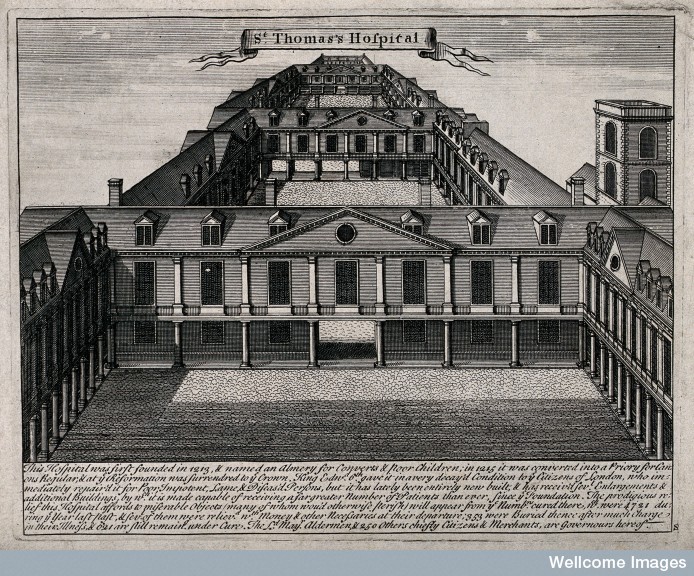Out-Letter Books: Copies of Correspondence Sent from St Thomas's Hospital (LB)
 London Metropolitan Archives, St Thomas's Hospital, Out-Letters Book, 1743-69, Ms H01/ST/A/86/002, LL ref: LMTHLB550020052
London Metropolitan Archives, St Thomas's Hospital, Out-Letters Book, 1743-69, Ms H01/ST/A/86/002, LL ref: LMTHLB550020052
Introduction
Correspondence by letter and note was an essential part of any eighteenth-century administrative system, and if anything, became more important over the course of the century as the Post Office became ever more efficient.1 An institution or individual's out-letter book provided one half of the record of a two-way correspondence, and was a necessary component of any well managed office.
St Thomas's Hospital
The three out-letter books included on this website all originate from St Thomas's Hospital. The hospital was both a provider of medical care and an important landowner, and the out-letter books reproduced here reflect both its role in the care of the sick, and its efforts to collect rent and renew leases for the lands and buildings it owned. The latter type of correspondence in by far the most common.
 Old St. Thomas's Hospital, Southwark. Early eighteenth century. Wellcome Library no. 39271i. © The Wellcome Library, London.
Old St. Thomas's Hospital, Southwark. Early eighteenth century. Wellcome Library no. 39271i. © The Wellcome Library, London.
Layout and Content
Rough copies of letters sent from the hospital were entered in the out-letter books in chronological order. There is no attempt to index this material or order it by subject matter, so a letter detailing the care provided for an individual patient can normally be found next to one barracking a tenant for overdue rent.
Several individual letters can be found on any single page, and each is separated from the previous one by a strong horizontal line. Beneath this line is the date on which the next letter was written or sent, followed by the text of the letter itself. The full name of the recipient and their address is included at the bottom.
It is unlikely that the full text of each letter as actually sent is reproduced in the letter books. These were working documents and marginalia and personal asides were probably excluded, as were more formulaic aspects of the correspondence such as honorific salutations.
Introductory Reading
- Siena, Kevin. Venereal Disease, Hospitals and the Urban Poor: London's "Foul Wards", 1600-1800. Rochester (NY), 2004.
- Thomas, Keith. The Meaning of Literacy in Early Modern England. In Bauman, G., ed., The Written Word: Literacy in Transition. Oxford, 1986, pp. 97-131.
- Whyman, Susan. The Pen and the People: English Letter Writers, 1660-1800. Oxford, 2009.
Online Resources
- London Metropolitan Archives
- The Old Operating Theatre
- AIM25: St Thomas's Hospital Medical School Records
For further reading on this subject see the London Lives Bibliography.
Documents included on this Website
- St Thomas's Hospital, Out-Letters Book, 1704-43, London Metropolitan Archives, Ms. H01/ST/A/86/001, LL ref: LMTHLB55001, Tagging Level: B
- St Thomas's Hospital, Out-Letters Book, 1743-69, London Metropolitan Archives, Ms. H01/ST/A/86/002, LL ref: LMTHLB55002, Tagging Level: B
- St Thomas's Hospital, Out-Letters Book, 1775-1807, London Metropolitan Archives, Ms. H01/ST/A/86/003, LL ref: LMTHLB55003, Tagging Level: B
Footnotes
1 Susan Whyman, The Pen and the People: English Letter Writers, 1660-1800 (Oxford, 2009), pp. 46-71. ⇑